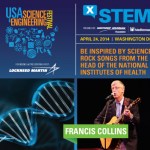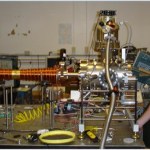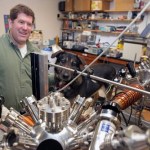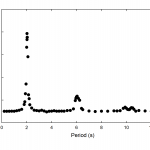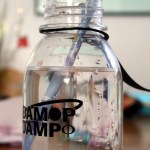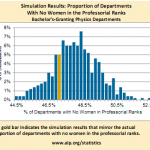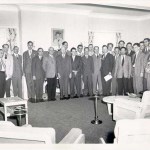Science
One of my colleagues at Union is doing a physics education research project with a summer student, and is using an online survey to collect data. Obviously, the more people respond to the survey, the more scientific it becomes (subject to the limitations imposed by relying on self-selected Internet samples, of course), so I offered to plug it here. Here's the blurb and link:
I'm doing a summer research project at Union College with a student, and I need as many people as possible to fill out a survey that we created. If you complete the survey by 11:59pm (EST) on Sunday, August 11, 2013, you…
SteelyPalooza came off very well, despite high disaster potential. We were, after all, inviting a dozen five-year-olds plus assorted siblings to our house, on a day when Kate and The Pip were out of commission due to coxsackie virus. Everything went smoothly, though: the kids loved the bouncy-bounce, SteelyKid's playset and playhouse, and the six-person tent we set up out back. They're getting close to an age where they can entertain themselves, so I was even able to enjoy snatches of adult conversation during brief lulls in my hosting duties.
This was, however, thoroughly exhausting, so…
X-STEM - presented by Northrop Grumman Foundation and MedImmune - is an Extreme STEM symposium for elementary through high school students featuring interactive presentations by an exclusive group of visionaries who aim to empower and inspire kids about careers in science, technology, engineering and mathematics (STEM). These top STEM role models and industry leaders are sure to ignite your students’ curiosity through storytelling and live demonstrations.
Our spotlight on our X-STEM Speakers begins with Geneticist, Physician and Director of the NIH, Dr. Francis Collins.
Raised on a…
The Pip is home with coxsackie virus today, and we're having a big party for SteelyKid tomorrow (her fifth birthday is next week), so I'm too busy to do more cold-atom blogging today. So instead, we'll consider one of the great linguistic conundra of modern physics:
The document preparation system LaTeX is pronounced:
This is a purely classical poll, so you can choose one and only one answer, not a quantum superposition of several. And if you choose wrong, everybody will point and laugh. No pressure, though...
Thursday's tempest-in-a-teapot was kicked off by an interview with Dan Vergano in which he suggests science reporting is a "ghetto:"
The idea, and it comes from the redoubtable Tom Hayden, is that science reporting has largely become a secret garden walled off, and walling itself off, from the rest of the world. Instead of reporting on the scientific aspects of news stories — whether Iran really will have the bomb, whether Quantitative Easing will spark inflation, whether Peak Oil is a real concern — we write pretty entertainments about mummies, exploding stars and the sex life of ducks. All…
The last post in this series on the core technologies of cold-atom physics dealt with optical molasses, where you use the scattering of light to exert forces on atoms to make them very, very cold. It turns out, they end up even colder than the simple theory would lead you to expect, which is very surprising, but also essential to the revolutionary impact of cold atom physics. If you were stuck with the Doppler cooling limit temperatures, laser cooling probably wouldn't be as big a deal as it is now.
You can do better, though, thanks to the interaction of several bits of physics that go beyond…
`Once upon a time there were three little sisters,' the Dormouse began in a great hurry; `and their names were Elsie, Lacie, and Tillie; and they lived at the bottom of a well--'
`What did they live on?' said Alice, who always took a great interest in questions of eating and drinking.
`They lived on treacle,' said the Dormouse, after thinking a minute or two.
`They couldn't have done that, you know,' Alice gently remarked; `they'd have been ill.'
`So they were,' said the Dormouse; `VERY ill.'
-- Lewis Carroll, Alice's Adventures in Wonderland, Chapter 7
As an undergrad, I did my senior…
This series of posts is intended to explain the tools and tricks used to create and manipulate samples of ultra-cold atoms; thus, it's appropriate to start with how we get those atoms in the first place. This will be a very quick background on the basic force used to make atoms cold, and then the technology of atom sources for a variety of experiments.
Okay, so you've got two things in the post title. Which are we going to talk about first? Well, the study of cold atoms really begins with the observation that light can be used to push atoms around. There are actually two ways to do that, but…
I have a small collection of recent research papers that I'd like to write up open in various browser tabs and suchlike, but many of these would benefit from having some relatively clear and compact explanations of the underlying techniques. And while I can either dig up some old posts, or Google somebody else's, it's been a while since I wrote some simple, straightforward explanations of physics techniques, so I thought it'd be fun to write up some new explanations for use in future posts. Thus, this introduction to a series of techniques commonly used in my corner of Atomic, Molecular, and…
Over at Galileo's Pendulum, Matthew Francis expresses an opinion that's sure to get him in trouble with the Inquisition and placed under house arrest: Carl Sagan's Cosmos isn't all that:
However, even taking into account the differences in TV between 1980 and 2013, the show is very slow-paced at times. I’m not talking about the mellow oh-so-1970s Vangelis score, or Sagan’s measured style of speech: I mean the obvious stretching of material to make hour-long episodes. I have a long attention span, so I’m not saying Cosmos should be like the frenetic Star Trek reboot; I’m just saying that a…
One of the great things about this blog is the community that has built itself up over the last eight and a half years of this blog's existence. It's a truly amazing an humbling thing to me. I can't believe that such an incredibly smart and talented bunch of advocates, gadflies, and quackbusters. True, I've also had my share of trolls, most frequently of the antivaccine variety, but you guys all take care of them so well that I only seldom feel the need to intervene myself. That's why, from time to time, I like to try to intentionally (rather than unintentionally) spark a bit of conversation…
Dealing with various creationists, you quickly begin to recognize the different popular flavors out there.
The Intelligent Design creationists believe in argument from pseudoscientific assertion; "No natural process can produce complex specified information, other than Design," they will thunder at you, and point to books by people with Ph.D.s and try to tell you they are scientific. They aren't. Their central premise is false, and trivially so.
Followers of Eric Hovind I find are the most repellently ignorant of the bunch. They love that presuppositional apologetics wankery: presuppose god…
Sign Our Petition: Support Science And Education Today!
Join Rep. Randy Hultren (R) and Rep. Joe Kennedy (D) in urging Congress to vote for H. Res. 276, which calls upon the U.S. House of Representatives to support the goals and ideals of National Science Week and the biennial USA Science & Engineering Festival in Washington, D.C.. The resolution also calls on State and local governments to recognize the last week in April, 2014 as a National Science Week.
Click here to read and sign the petition.
Some time back, I spent a bunch of time writing a VPython program that simulated the motion of a pendulum, which turned out to do some strange things. In the comments to that, there were two things worth mentioning: first and foremost, Arnoques at #5 spotted a small error in the code that fixes the odd behavior noted in that post-- when I corrected it, the stretch needed to keep the pendulum swinging smoothly without oscillating in and out along the string was exactly what you would expect (the "factor" plotted in that earlier post is infinitesimally smaller than 1.0-- I got bored trying to…
The other day, I made a suggestion to one of my research students of an experiment to try. When I checked back a day later, she told me it hadn't worked, and I immediately realized that what I had told her to do was very stupid. As penance, then, I'll explain the underlying physics, which coincidentally has a nice summer-y sort of application alluded to in the post title.
If you're the sort of person who enjoys swimming, and can either open your eyes underwater or regularly wear a mask or goggles, you've probably notice that the underside of the surface of a swimming pool or other body of…
I've spent a bunch of time recently blogging about baseball statistics, which you might be inclined to write off as some quirk of a sports-obsessed scientist. I was very amused, therefore, to see Inside Higher Ed and ZapperZ writing about a new AIP report on women in physics (PDF) that uses essentially the same sort of rudimentary statistical analysis to address an important question.
I say "amused" because of the coincidence in methods, not because of the content. And, in fact, the content is... not likely to make them friends in a certain quarter of the blogosphere. I actually flinched when…
I'm doing edits on the QED chapter of the book-in-progress today, and I'm struck again by the apparent randomness of the way credit gets attached to things. QED is a rich source of examples of this, but two in particular stand out, one experimental and the other theoretical.
On the experimental side, it's interesting to note that one of the two experimental effects that really galvanized the theoretical effort leading to QED bears the name of a particular person, while the other does not. Ask any physicist about the origin of QED, and they will almost certainly be able to cite the "Lamb shift…
This is a public service announcement:
the EU is running a FameLab like Science Slam
EURAXESS Researcher in Motion Science Slam, sponsored by the European Commission.
"If you are a researcher currently based in North America (US and Canada), enter the competition by posting a video featuring your science slam on our LinkedIn site, or upload it on YouTube or DropBox and send the link directly to northamerica@euraxess.net before 10 September 2013.
Up to 7 entries will be invited to join the EURAXESS Science Slam North America 2013 finals to be held on the campus of the American University in…
Time really does fly. It's hard to believe that it's been over a week since I gave my big (to me, at least) talk at TAM. It's equally hard to believe that it's been more than a week since I had the honor of being kicked out of Penn Jillette's Private Rock & Roll Bacon & Doughnut Party because back in February I had had the temerity to question whether it was a good idea for Penn & Teller to appear on The Dr. Oz Show. It was a surreal experience, to be sure, to be cussed out publicly (albeit with no mention of my name), kicked out of Penn's private party, and then to have had Penn…

